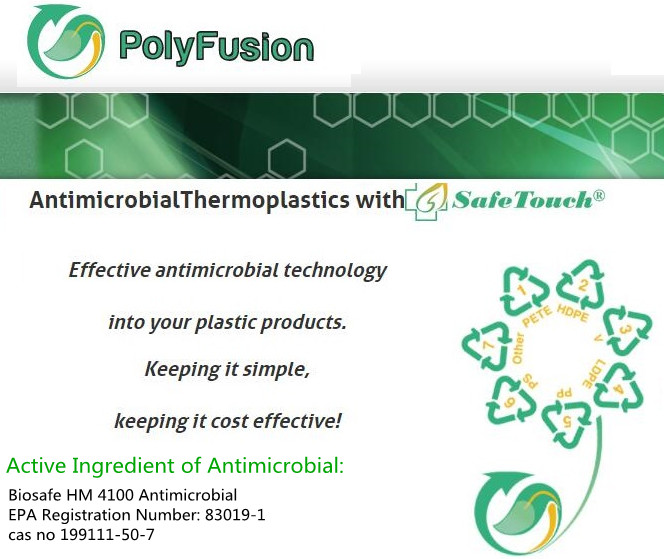SafeTouch / Biosafe HM 4100 Antimicrobial
what is SafeTouch and is it safe to use?
When we consider an antimicrobial that is EPA registered (Biosafe HM 4100 Antimicrobial with EPA Registration Number: 83019-1, cas no 199111-50-7) we can be assured that the technology has been subject to rigorous scrutiny before its approval for use in the public domain. The EPA registration is very specific in the applications for which the technology is approved for. However, understanding the various antimicrobial technologies is a responsibility for all who are incorporating them into plastic products for everyday use.
The purpose of an antimicrobial?
Plastics are composed of polymers and their enhancing additives, with most being from organic petrochemical or biomass feedstock. Because of this they are susceptible to attack by microorganisms who view the plastic as a source of food. The inclusion of an antimicrobial in this scenario is to protect the plastic from degradation by microorganisms. A second benefit from the inclusion of antimicrobials in plastics is the ability to reduce the number of colony forming units [CFUs] of microorganism which include those creating perilous environments. The result is a surface that is significantly enhanced to resist the transfer of microorganism by touch as well as reducing discoloration and odors.
How do antimicrobials work?
Most antimicrobials are dependent on the targeted microbe to either ingest or absorb the antimicrobial’s active ingredient directly or by ionic exchange. In order to facilitate this consumption by the microbes, a hydrophilic environment is necessary to insure the antimicrobial is readily available. This is referred to as the “leaching” process in which moisture dependent antimicrobial technologies function. Once a microorganism comes in contact with the inhibition environment it must then absorb or ingest the antimicrobial active. The antimicrobial then begins the disruption of the microorganism’s metabolic functions necessary for survival and reproduction. The organosilane antimicrobial has a mode of action that is based on molecular penetration of the microbe’s cellular membrane. This mode of action is a physical softening and then rupture of the microorganism’s cell wall and is not dependent on leaching to be available.
Are there end of life issues for antimicrobials?
When the functional life of a plastic product containing antimicrobials is reached, the behavior of the antimicrobial needs to be considered? If the technology is dependent on leaching, does the antimicrobial continue to leach? If and when the plastic decomposes, does the antimicrobial active decompose?
How do you measure the effectiveness of an antimicrobial in plastics?
There is the actual metric of measurement for efficacy and reported in terms of log reduction or percentage reduction of the microorganism colony forming units (CFU) specified within the applicable test protocol. The leaching antimicrobials use a 24-hour timeline in their test protocols. The JIS Z-2801 or ISO 22196:2007 protocols utilize a cover-slip technique for 24-hours of contact between the treated article and the test inoculum. Non-leaching antimicrobials use the ASTM E2149-10 protocol, the inoculum is placed within a flask and the treated article is dynamically (shaken) exposed to the inoculum for 1-hour. The ASTM G-21-09 is a common protocol used to determine resistance to fungi in polymeric materials containing antimicrobials.
